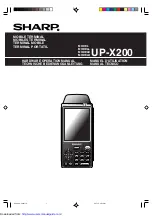
2: Installation
APCD-WM001-1.0
16
2.3.5 Testing the Data Link
Omni-directional Mobile Antennas are designed to capture radio signals from any direction.
Repositioning the antenna (or vehicle) may be needed if the signal levels are not adequate in
a given location. Generally, it is better to have the antenna as high as possible. Also the
further away from surfaces that can reflect the radio waves the better, so parking away from
buildings is usually better.
When using the panel antenna at a new location, be sure to orient the antenna so that it is
pointing at the best signal.
Use the Radio LED to help in positioning or orienting the antenna. The Radio LED will flash
more quickly if the signal improves. If the Radio LED does not flash at all, then there is no
radio signal in that position or orientation.
Alternatively, the Setup Menu as described in
, Setup Menu provides the figures of
merit for the signal. The goal for a good installation is to have the Signal Strength FOM in the
range of 5-8 and the Signal Quality FOM to be in the range 4-5. However, there are many
good installations with lower figures of merit. Using the LEDs or Setup Menu, you can
determine if the location has adequate figures of merit. MMT9000. In most cases, a signal
strength of 5 with a signal quality of 4 is a better signal that a signal strength of 6 and signal
quality of 2.
The following are simple tests that the installer or end-user can perform to ensure that the link
is functioning correctly. These tests may be used for each new location, especially if the link
does not appear to be working as expected. If any test fails, then the subsequent tests are
likely to fail as well until the problem is resolved
NOTE:
Turn off all cordless phones in the customer’s premises, and any
other equipment that uses the 900MHz ISM band. Once the
installation is complete, turn this equipment back on and monitor
for interference or degraded signal quality.
1.
Ping the
MMT9000: Configure the end-user’s PC to have an IP address on subnet
169.254.x.x and ping the MMT9000 at IP address “169.254.10.250” (see
on page 17 for more details if needed).
2.
Assess the Link
: Use the Setup Menu as described in
on page 21 to
assess the Radio Link Status and to get the Troubleshooting information to baseline
the installation. This test verifies that the end-user’s PC is communicating with the
MMT9000 and provides insight into the state of the RF link. This test is recommended
since it provides details on the state of the modem and what Base Station(s) it has
located.
3.
Verify DHCP
: If the network assigns end-user PC’s IP addresses by DHCP, then
reconfigure the end-user PC to use DHCP to automatically obtain its IP address.
Verify the end-user PC has received an IP address, by using the DOS command
“ipconfig” and seeing that an IP address is assigned along with Gateway and DNS
server addresses This confirms that the End user PC is contacting the DHCP server
correctly.See
on page 18 if more details are required.
4.
Ping the Gateway
: Assuming the end-user PC has an IP address and a Gateway
address as shown by the “ipconfig” command, ping the gateway to determine if it can
Содержание MMT9000
Страница 1: ...MMT9000 Installation Guide APCD WM001 1 0...












































